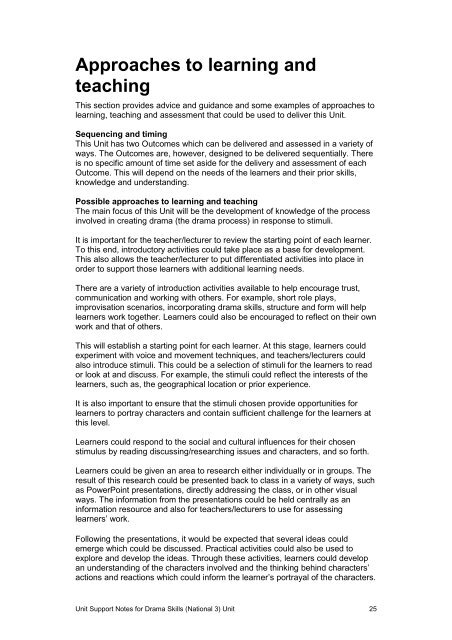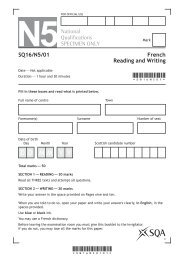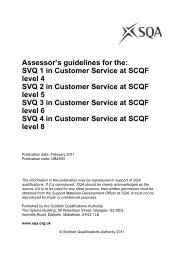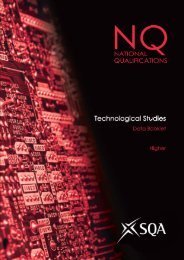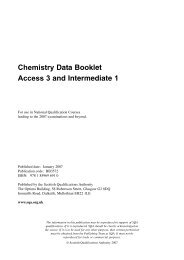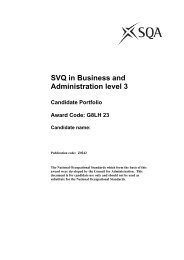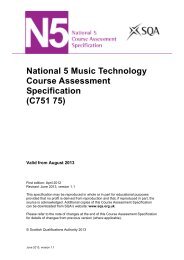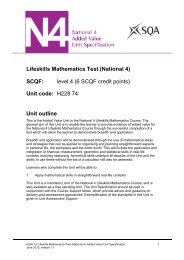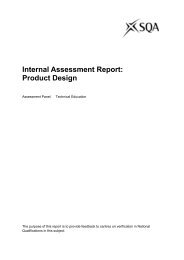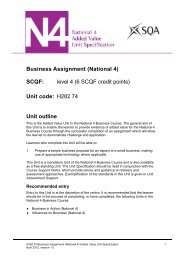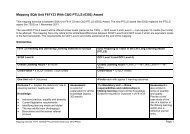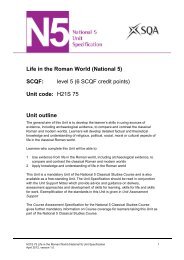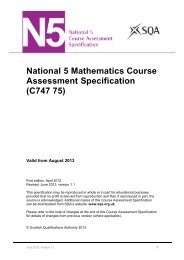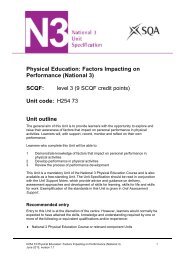National 3 Drama Course Support Notes - Scottish Qualifications ...
National 3 Drama Course Support Notes - Scottish Qualifications ...
National 3 Drama Course Support Notes - Scottish Qualifications ...
Create successful ePaper yourself
Turn your PDF publications into a flip-book with our unique Google optimized e-Paper software.
Approaches to learning and<br />
teaching<br />
This section provides advice and guidance and some examples of approaches to<br />
learning, teaching and assessment that could be used to deliver this Unit.<br />
Sequencing and timing<br />
This Unit has two Outcomes which can be delivered and assessed in a variety of<br />
ways. The Outcomes are, however, designed to be delivered sequentially. There<br />
is no specific amount of time set aside for the delivery and assessment of each<br />
Outcome. This will depend on the needs of the learners and their prior skills,<br />
knowledge and understanding.<br />
Possible approaches to learning and teaching<br />
The main focus of this Unit will be the development of knowledge of the process<br />
involved in creating drama (the drama process) in response to stimuli.<br />
It is important for the teacher/lecturer to review the starting point of each learner.<br />
To this end, introductory activities could take place as a base for development.<br />
This also allows the teacher/lecturer to put differentiated activities into place in<br />
order to support those learners with additional learning needs.<br />
There are a variety of introduction activities available to help encourage trust,<br />
communication and working with others. For example, short role plays,<br />
improvisation scenarios, incorporating drama skills, structure and form will help<br />
learners work together. Learners could also be encouraged to reflect on their own<br />
work and that of others.<br />
This will establish a starting point for each learner. At this stage, learners could<br />
experiment with voice and movement techniques, and teachers/lecturers could<br />
also introduce stimuli. This could be a selection of stimuli for the learners to read<br />
or look at and discuss. For example, the stimuli could reflect the interests of the<br />
learners, such as, the geographical location or prior experience.<br />
It is also important to ensure that the stimuli chosen provide opportunities for<br />
learners to portray characters and contain sufficient challenge for the learners at<br />
this level.<br />
Learners could respond to the social and cultural influences for their chosen<br />
stimulus by reading discussing/researching issues and characters, and so forth.<br />
Learners could be given an area to research either individually or in groups. The<br />
result of this research could be presented back to class in a variety of ways, such<br />
as PowerPoint presentations, directly addressing the class, or in other visual<br />
ways. The information from the presentations could be held centrally as an<br />
information resource and also for teachers/lecturers to use for assessing<br />
learners’ work.<br />
Following the presentations, it would be expected that several ideas could<br />
emerge which could be discussed. Practical activities could also be used to<br />
explore and develop the ideas. Through these activities, learners could develop<br />
an understanding of the characters involved and the thinking behind characters’<br />
actions and reactions which could inform the learner’s portrayal of the characters.<br />
Unit <strong>Support</strong> <strong>Notes</strong> for <strong>Drama</strong> Skills (<strong>National</strong> 3) Unit 25


